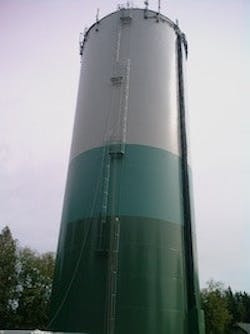Active Mixer Eliminates Stratification in Standpipe
The Spanaway Water Co. in Washington discovered thermal stratification in its standpipe after noticing heavy condensation on the outside wall of the steel tank. The operator expected that the cold water inside the tank was causing the condensation, but was alarmed that the condensation was only visible 20 ft up the side of the 127-ft standpipe. To test his theory that the tank was thermally stratified, the operator installed a series of submersible temperature probes at 20-ft intervals inside the tank. The investigation revealed severe thermal stratification with temperature differences as great as 19°F between the upper and lower layers. Even worse, water samples indicated 0.7 mg/L chlorine residual at the bottom of the tank and almost zero residual at the top. This warm, low-residual water would remain trapped in the top of the standpipe until a period of high demand allowed the poor quality water to enter the distribution system, potentially triggering taste and odor complaints.
Tank Geometry
Standpipes are the most challenging tank geometry to mix because of the large ratio between the tank’s height and diameter. Tall and skinny standpipes are the most prone to thermal stratification because water easily becomes trapped and isolated at the top of the tank. The water entering the tank doesn’t provide enough circulation because the inlet velocity is too feeble and comes in at a horizontal angle. Additionally, the majority of water in the standpipe must remain in the tank to maintain water pressure in the distribution system (typically 70 to 90% of capacity). Given these challenges, only a mixer with a truly powerful jet can circulate water from the bottom to the top of a standpipe.
Power Makes the Difference
The installation of an active mixer in the Spanaway standpipe took less than a day and required no crane or heavy equipment. The benefits were immediate—the single active mixer was able to penetrate each thermally stratified water level and completely circulate the entire tank. Every hour that the active mixer operated, a vertical foot of the stratified water column was blended with the cool, residual-rich water coming into the tank. After seven days, the entire standpipe was completely mixed and the temperature of the upper layer had fallen from 66°F down to below 61°F. Grab samples taken after one week of mixer operation showed a dramatic increase in residual at the top of the tank: from 0.00 mg/L to 0.31 mg/L. With the active mixing, water quality throughout the tank has been improved and the entire volume of water is now available for emergency use.
Comparing Mixers, Apples-to-Apples
The price of a mixer can vary when comparing different technologies, but the bigger difference between mixers on the market is their pumping rates. A mixer’s pumping rate is usually in the range of hundreds to thousands of gallons per minute and can vary by a factor of 10. While a mixer’s impeller may create a small jet of high velocity water, most of the pumping comes from how that jet entrains and mixes with the surrounding water. The total fluid movement (direct and indirect) that a mixer produces is the pumping rate. To determine a mixer’s total pumping rate, a Computational Fluid Dynamics (CFD) model needs to be developed and calibrated with actual data gathered from water tanks. Examining CFD models that are calibrated with data is very important when evaluating mixing technologies, and is the best way to compare mixers apples-to-apples.
To learn more about water quality solutions from PAX Water Technologies, click here.
Dr. Peter S. Fiske is the CEO of PAX Water Technologies. Fiske can be reached at [email protected] or 866.729.6493.
